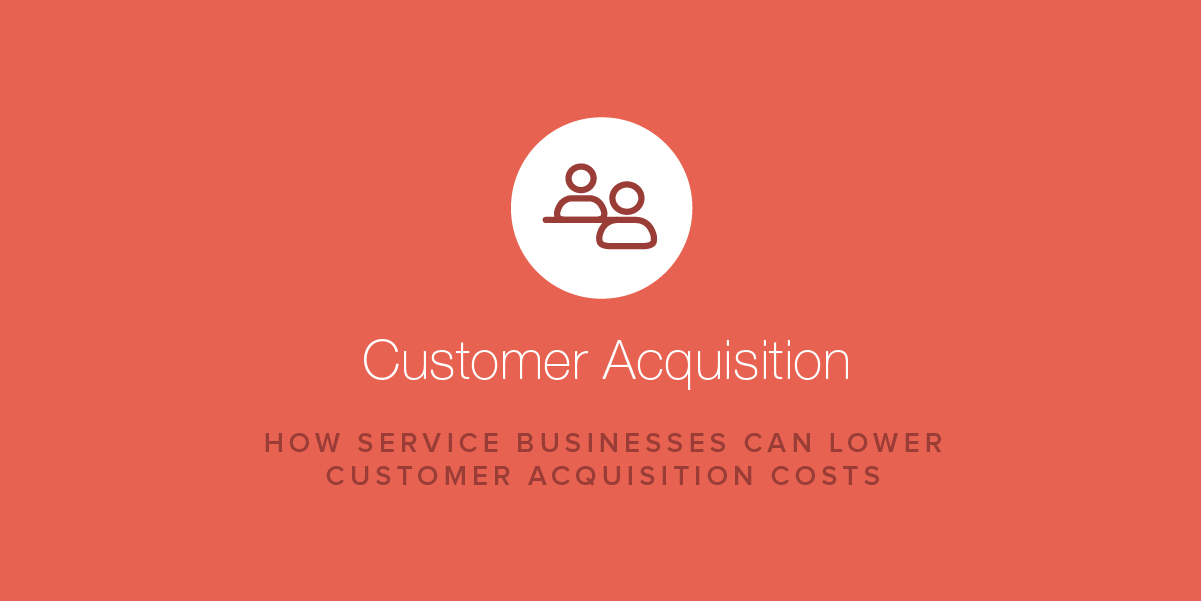How Service Businesses Can Lower Their Customer Acquisition Costs
- November 22, 2018
- By: Vonigo
This article about lowering customer acquisition costs is byTyler Brooks, Founder of Analytive.

One of the biggest challenges for service businesses is acquiring new customers.
A secret to growth for service businesses is lowering your customer acquisition costs (CAC). This is because if you can lower your CAC, you can stretch your marketing budget while increasing opportunities to develop new business.
Understanding CAC, for Service Businesses
Before we discuss the ways to lower CAC, let’s define CAC.
The calculation is simple but will require you to have an understanding of your business finances.
Here’s the Formula:
Total marketing spend / number of new customers =
Customer Acquisition Cost
For example, if you spent $10,000 on marketing last year, and you acquired 100 new customers, your CAC is $100. After all, $10,000/100 = $100.
Lowering your CAC means that you make the same number of marketing dollars go farther in your business. That translates to more clients for the same amount of money. And that’s what we want.
![]()
Now, what is the strategy to improve this number? Here are a few ways we’ve found to lower customer acquisition costs in your business:
1. Fix Your Website
The lowest hanging fruit for almost any business already generating web traffic is to boost their conversion rate on their website.
The conversion rate of the site is simply how many people that visit your site actually convert. If you had 100 visitors to your website but only 1 reached out to you, that’s a 1% conversion rate. Typically websites average anywhere from 1%-5%.
Here’s the amazing news: if you’re building your site properly, some landing pages convert as much as 50%!
Here are a few quick ways to increase conversion rate:
Advertise a Better Offer
In order to get people to convert, you need a great offer. Can you give away something for free? Stack some bonuses on your offer? A well-run website offer will likely replace any upfront money in upsells or repeat customers.
Focus especially on perceived value that isn’t a huge investment. Perhaps you could create a video series on “How to pack a TV for moving” or “How to minimize wear and tear on furniture while you’re moving.”
Shorten Your Forms
When asking for a visitor’s information, don’t ask for everything. What do you actually need for a follow-up? Often a first name, phone number, or email is enough.
The more you ask for, the less likely someone is to complete the form. Ask for only what is initially essential, then get the rest of the information on the follow-up.
Focus on Your USP (Unique Selling Proposition)
Be sure to highlight what makes you unique. Are you price competitive? Do you offer a white-glove service? Do you guarantee a specific delivery time?
Learn what separates you from the competitors in your industry, then highlight it. Customers shop around, so let them know why they should choose you.
2. Use High Leverage Channels
Archimedes said, “Give me a lever long enough and a fulcrum on which to place it, and I shall move the world.”
Leverage is a powerful thing in your business as well. In order to really understand how it works, let’s compare a leveraged vs. an unleveraged channel.
First, let’s talk about a traditional pay-per-click (PPC) search. These are normally done through Google Ads, although Bing is another, less popular, option.
Bidding for Keywords
In traditional PPC, you pay everytime someone clicks on your ad. That means your cost for acquiring a customer is highly fluctuating. If you get a lot of clicks, you pay a lot more money.
Plus, a competitor can quickly come in and bid up the price. As an example, if you bid on “Moving Services in Phoenix”, the average cost per click is around $17! That means everytime someone clicks on your ad, you instantly pay $17. It’s a great way to get customers in the door, but it can get expensive very quickly.

A quick search reveals that at the time of writing, a “moving services in Phoenix” click is around $17.46. That can be a huge strain on a small business budget.
Unfortunately, not every click is going to convert. Many people will just be “shopping” around looking for the best deal.
That’s why with paid search, it might cost you hundreds of dollars just to get a client! If your site has a 10% conversion rate, only one in every 10 clicks will convert! That means you’re paying at least $170 for a lead from PPC.
That means pay per click is NOT a highly leveraged channel.
SEO > PPC
Search engine optimization (SEO), on the other hand, could be a very high leveraged channel.
People are often distrustful of ads and will naturally go to the top “organic” (non-sponsored) results on a post. Getting your business in these top 10 results can be expensive because you’ll need to invest a lot in content and backlinks. However, once you are there, you can begin to capture a huge number of searchers with very little additional investment.
SEO usually is a fixed cost, thus allowing you more leverage. Once you’re winning on that channel, you’ll capture many clicks without having to pay for each one.
In order to reduce your customer acquisition cost, you’ll want to find and utilize as many of these highly leveraged channels as possible.

3. Review Your Review Game
For many service businesses online, like moving and cleaning, your business lives and dies on the quality of your reviews. Many people have examples of moving and cleaning companies who have treated them poorly and will write reviews online about the company, thus damaging their reputation and their opportunity for future business.
For me personally, I had a terrible experience with a cross-country moving company. If I had read the reviews ahead of time, I likely would’ve picked a different company.
In order to really take your customer review game to the next level, there are a few things you can do:
Give Great Service
The first and most obvious way to get good online reviews is to give great service. If you’re getting a lot of negative reviews, you’ll want to really look at your business. If you can’t begin by giving good services, none of the other tips I list will help.

Deal with Negative Experiences Directly
One of the best ways to do this is to set up an automated follow-up during and after the sales transaction from your manager or owner.
You should be able to program this in your service business management software, customer relationship management (CRM) or marketing automation software. Normally, this is going to be an email or a text that reaches out to your client and says something like: “Thanks for letting us work with you. Your furniture is currently in transit and will arrive at your destination on {date}. If you have any questions or concerns, please feel free to email or call me at {email} or {phone number}.”
A similar email or text would be sent after the service is rendered. The key is to make it personalized and have a manager to address any complaints directly. For example, you could say: “Hi, this is Ted at {your company}. We wanted to reach out and make sure you were happy with the service we provided. If you have any feedback, we’d love to hear from you at {email} or {phone}.”
Promote Positive Reviews
The goal is to identify and address any negative issues before they make it to the online review sites. You’ll never eliminate all issues. Sometimes customers aren’t the most understanding or your team will actually make a mistake. However, you want to get problems resolved before the customer feels the need to post it.
Once you’re fairly sure they don’t have any major negative experiences, you want to ask the customer to complete a review online. You can do that by sending another follow-up letter, text, or email. We recommend only asking for a review on one or two platforms. The most common are Facebook, Google, and Yelp, although dozens of others exist.
Address all Reviews Quickly
Finally, you want to respond to both positive and negative reviews online. We’re assuming you’ve already claimed your business listing, so you need to go in and respond.
Even a thank you to positive reviews goes a long way. In regards to a negative review, reaching out with the intent to resolve issues can show how much you actually care about your customers.
4. Push For Referrals
Incentivizing referrals is a great way to build brand and reputation. You can even offer a little gift to your customers when they refer a client.
Here are some examples of gifts you could give:
- T-Shirt
- Stickers
- Amazon Gift Card
- Restaurant Gift Card
- Phone Case
- Smartphone Popsocket
Most of these gifts can be purchased for under $10 – meaning they would successfully peg your customer acquisition cost at around $10. That’s less than a click on some paid search ads!
Word of mouth is still the best method of marketing. Therefore, be sure to leverage it as much as possible. Incentivizing referrals is one of the simplest ways to do that.
 Tyler Brooks is the founder of Analytive and does Digital Marketing and SEO for a variety of companies across industries and verticals.
Tyler Brooks is the founder of Analytive and does Digital Marketing and SEO for a variety of companies across industries and verticals.
If you’re wanting to grow your business, you can learn more about their services as well as take their online SEO training and Google Analytics courses.



